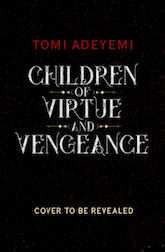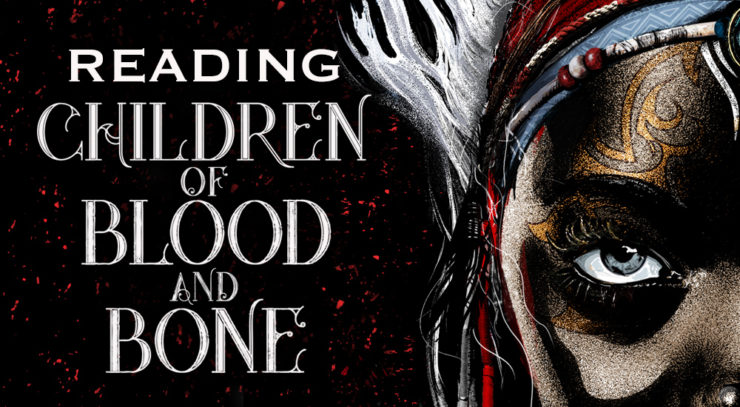This week, our ongoing reread of Children of Blood and Bone by Tomi Adeyemi continues with chapters 18-30, in which Inan goes all in with his magic, Tzain discovers his inner strategist, Amari cracks under pressure, and Zélie wages a deadly sea battle in the middle of a desert.
Recap
In the abandoned temple, Lekan retells the story of the origin of the gods to our trio. He also reveals how Saran severed the connection between the maji and the gods—and how to restore it by retrieving the sunstone and reaching a mystical island in the Orinion Sea by the “centennial solstice, the tenth centenary of Sky Mother’s gifts to mankind.” To kickstart the ritual process, he also tethers Zélie to the Sky Mother. Just as she resurfaces from the spell back into the real world, they’re interrupted by the unexpected arrival of Inan and Kaea.
After a terrifying escape from the temple (during which Kaea kills Lekan), Zélie, Tzain, Amari, and Nailah traverse the desert on their way to Ibeji. The town is small but crowded with greedy rich people, drunk guards, and starving divîner slaves. The slaves compete in a pseudo-sea battle in a desperate attempt to win Babalúayé’s jewel of life, staged for the amusement of the nobles and merchants. Convinced that the prize is really the sunstone, the trio attempt to break in and steal it. When they witness a boy being beaten by guards, Zélie instead decides to compete. But she has a secret weapon: a spell to awaken the dead. If she can muster the power to control the thousands of restless spirits haunting Ibeji, they’ll have a good chance at winning.
Meanwhile, Inan takes stock of the situation. The confrontation with Lekan was the first time he’d seen raw magic, which left him shaken and mourning the death of his snow leopanaire Lula: “In the face of magic we become ants.” He decides that the only way to capture the scroll is to use his magic, even though that will make him into the very thing he hates. His duty is to the kingdom, no matter the personal cost.
Later, as the enslaved rush to build a new bridge to replace the one the trio destroyed during their escape, Inan wanders through the temple and the past. In a rage, he sinks into his dreamscape. Although he feels peace there, he reminds himself that “It’s only the heart of my curse.” He unintentionally summons Zélie and they snipe at each other as per usual… until she discovers she can manipulate his world. Back in the temple, Inan’s emotions and magic get the better of him and he kills Kaea. At least one good thing results from all this: He now knows where the scroll is.
On their ship, Amari, Zélie, and Tzain muster their new divîner troops as they prepare for battle in the flooded arena. Not only have the ticket sellers jacked up the prices, but there are three times as many boats as before. With a general’s mindset, Tzain takes control. Zélie raises the spirits of the dead and sets them on the other ships. Amari tries to get her sword fighting on when the enemy boards her ship, but fear overpowers her.
Buy the Book


Children of Virtue and Vengeance
Not that it matters, anyway, when their ship is blown to smithereens.
Commentary
On a structural note, I’d say it was awfully coincidental that our protagonists find the scroll just in time for their last chance ever to undo Saran’s handiwork. Lekan makes it clear that the gods have been moving pieces around the board for a while to make this happen now, but still. If you’re a god who’s creating a plan that will remake the world, why not give yourself a few months to work with rather than wait until the last possible minute?
Inan’s intense self-loathing and creepy obsession with Zélie was almost overwhelming the first time I read the book, but I have to admit that the second time through it’s repetitive and annoying (and it’s only gonna get worse). But it’s also understandable, given that he was raised to believe in “duty before self” and that the maji are the worst thing ever to inhabit the earth. It’s no wonder he’s as screwed up as he is. Not only are his feelings for Amari getting in the way of his father’s commandments, but he’s now become the embodiment of the very thing he hates the most, the thing he believes is responsible for the worst period in Orïshan history, and the thing that will push him further from the man whose affection he’s so desperate for: his father.
Lekan killing the ryders is exactly the kind of act that reinforces Inan’s belief that maji are violent creatures. He sees an all-powerful being attacking weaker animals, all while ignoring that the leopanaires would still be alive if Inan hadn’t been hunting his sister in the first place. Lekan’s hand was forced by circumstances beyond his control, circumstances put into play by his oppressors who then punished him for reacting in the only way he could.
If Inan’s willful ignorance and insistence on alternative facts sounds familiar—good. It should. We see this in our world, too. Western colonial powers spend decades and even centuries ravaging resource-rich countries, then seal their own borders when the survivors come searching for a better life. We shame victims of police brutality for not listening to orders and resisting arrest while ignoring the rot growing inside the criminal justice system, a system specifically structured to harm, demean, dehumanize, and hold down the marginalized to the benefit of the majority.
Which brings me to another point: All too often I hear readers bemoaning what they see as authors increasingly shoving politics into speculative fiction where it didn’t use to be. They long for the days when stories were “just” stories, full of fun and action and no messages of social responsibility and inclusivity. The thing is, every piece of fiction is political. Fiction doesn’t live in a vacuum. Even the simplest and most traditional stories have an agenda of some kind. Who is included in the narrative and who is excluded is a political statement. Whether a female character is a sexy lamp or a fully developed character is a political statement. Who tells what kind of story—from the author who writes it to the editors, agents, and publishers who accept or reject it—is a political statement.
Readers demanding politics-free fiction want something that never existed, that can’t exist. You either choose to acknowledge the myriad ways in which politics impact fiction or you don’t, but ignoring it doesn’t mean it isn’t there. Yes, Children of Blood and Bone is more explicit about its politics than some young adult fantasies. And yes, I think that’s a good thing. It allows Adeyemi to drill down past the layers of fiction to get at the truth. To look at Zélie’s ordeal and see only an adventure quest is to completely overlook everything she’s been through and striving toward. Her very existence as a divîner is a political statement, whether she or anyone else wants it to be. We as readers should respect that.
Terminology
- Aiye: the maji of iron and earth. The name comes from the Yorùbá word for “earth.”
- Ògún: deity of Grounders and Welders. Based on Ògún, a warrior òrìṣà of iron, metallurgy, and war.
Place names
- Ibeji: the desert settlement. Name comes from the Yorùbá word for “twins,” and can also refer to the wooden statuettes carved after the death of one or both twins. Twins were initially reviled and killed, but eventually came to be revered. They are protected by their own òrìṣà.
- Ikoyi: a seaside town. Inspired by Ikoyi, a wealthy neighborhood in Lagos, Nigeria.
Will our trio survive the gladiator ring? Will Inan stress himself into oblivion? Will anyone remember to feed Nailah? Find out next week as we continue our reread with chapters 31-41.
Alex Brown is a high school librarian by day, local historian by night, author and writer by passion, and an ace/aro Black woman all the time. Keep up with her every move on Twitter and Insta, or follow along with her reading adventures on her blog.










